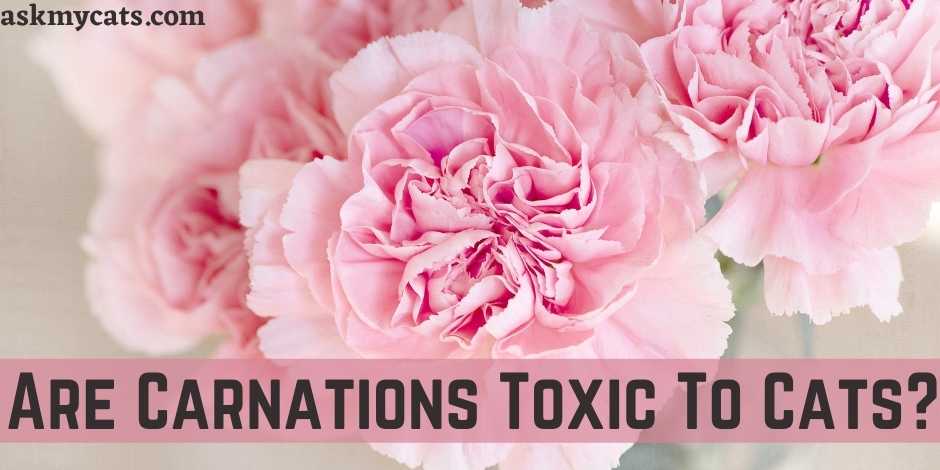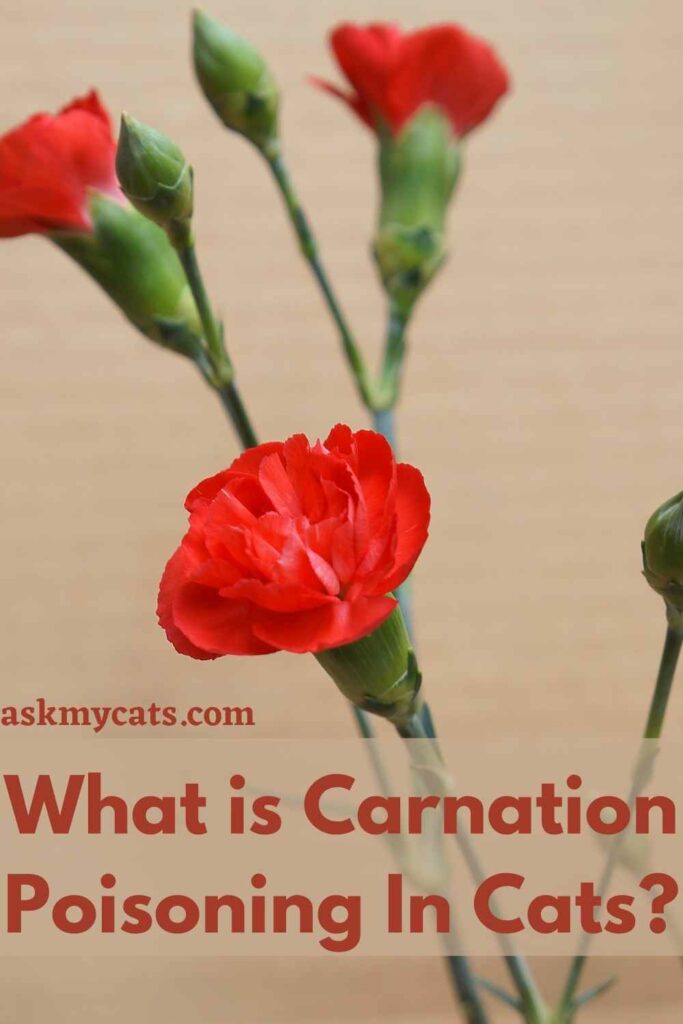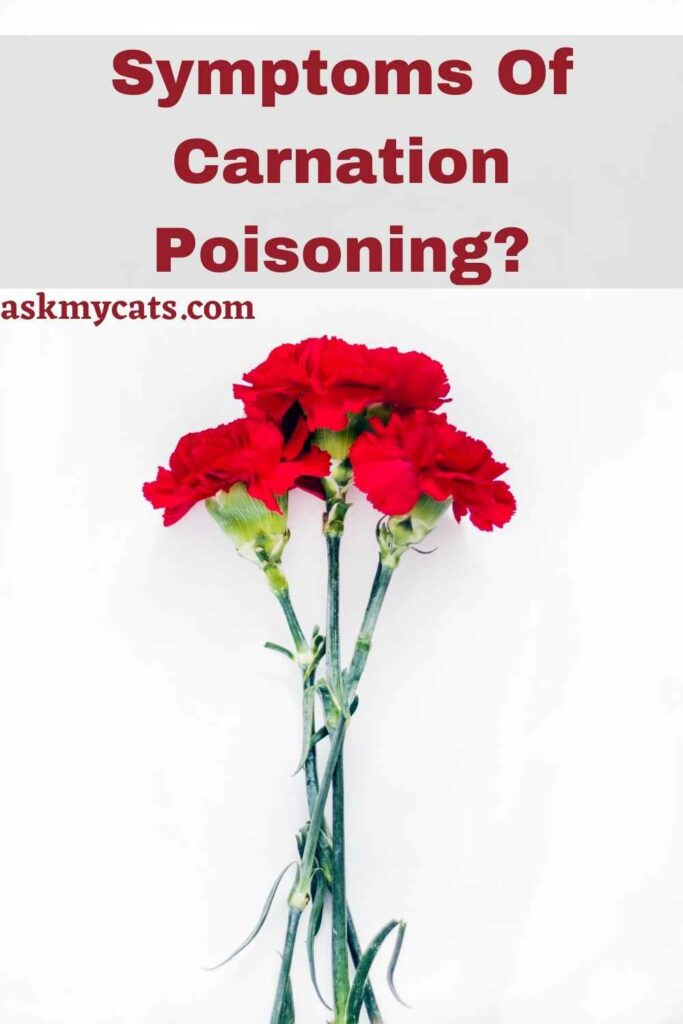Carnations are popular in the yard and in floral arrangements because they are attractive, aromatic, and long-lasting. They’re a perennial favorite thanks to their pleasant scent, gorgeous ruffled blooms, and romantic hues of pink and white.
Carnations take a long time to wilt or fade after being cut, which is why they’re still popular as a buttonhole accessory. If you’re going to have cats and carnations in the same spot, you’ll need to be cautious, as you would with a lot of our most popular houseplants and garden flowers.
So, is carnation toxic to cats?
Yes, carnations are mildly toxic to cats. Although carnations are not as harmful as some other flowers (such as lilies, tulips, and daffodils), they can induce mouth irritation, nausea, gastrointestinal pain, vomiting, and diarrhoea in cats. They can irritate a cat’s skin as well.
This article will talk about why carnations are toxic to cats and how to keep cats away from them.

Give Your Cat the Perfect Day
Get the Free Ebook!

What Are Carnations?
Carnation, (Dianthus caryophyllus), also called grenadine or clove pink, herbaceous plant of the pink, or carnation, family (Caryophyllaceae) is native to the Mediterranean area.
It’s frequently cultivated for its fringe-petaled flowers, which have a spicy scent and are often used in the florist business.
The border, or garden, carnations, and the perpetual flowering carnations are the two main types. Border carnations come in a variety of kinds and hybrids that range in height from 30 to 75 cm (1 to 2.5 feet); the flowers are usually less than 5 cm (2 inches) in diameter and are carried on wiry, stiffly erect stems.
The blue-green leaves are narrow and sheath the stems, with swellings at the leaf-stem junction.
The everlasting flowering carnation, which is thought to be a hybrid between border carnations and cottage pink (D. plumarius), is taller, reaching up to one meter (3 feet), stouter, and produces larger flowers, and blooms practically continually in the greenhouse. Perpetual carnations are also grown for the floral trade in miniature (baby) and spray variants.
Carnations are often used in floral arrangements, corsages, and boutonnieres, and are one of the most popular commercial cut flowers.
Anna Jarvis of Philadelphia chose the pink carnation as the Mother’s Day symbol in 1907. Historically, carnation was used to treat fevers in Europe.
During Elizabethan times, it was also used to spice wine and ale as a cheaper alternative to the more expensive clove (Syzygium aromaticum).
Are Carnations Cat-Safe?
No, carnations are not considered cat-safe as they are mildly toxic to cats.

Cats are poisoned by all parts of the carnation (also known as Dianthus or pinks).
The poisons aren’t particularly harmful, but they can still be unpleasant and stressful for the animal if it consumes a large amount.
The flowers may irritate your cat’s skin; if she rubs against them or rolls about in them, she may have an allergic response.
Itching, a rash, and fur loss are all possible side effects of over-grooming.
If your cat gets it into her head to bite on your carnations, she may have oral irritation.
She might start drooling a lot. She may become sick or have diarrhoea if she swallows parts of the plant.
Because eating carnations can cause gastrointestinal pain in cats, your cat may vocalize and fuss to draw your attention.
Alternatively, she may go away somewhere quiet to nurse her sore tummy. If this happens, you’ll need to track her down so she can get medical help; it’s also likely that she’ll foul her hiding area, causing a slew of issues for both her and you.
If your cat has eaten carnations or other hazardous plants, some individuals believe it’s a good idea to try to promote or induce vomiting.
In reality, this is extremely hazardous. For starters, it’s very simple for your cat to choke when doing so.
Furthermore, carnations are an irritant, and you are further irritating your cat’s fragile throat and mouth tissues.
Carnation poisoning is generally more uncomfortable than hazardous. Carnations, unlike other hidden hazards (like peace lilies and hyacinths), are unlikely to cause long-term harm, and I’m not aware of any cats who have died as a result of eating them.
However, the poisoning’s effects can cause dehydration, which is bad for your cat’s health. Experts strongly advise you to have your cat examined by a veterinarian; aside from anything else, she may have eaten something more harmful than carnations.
Symptoms of poisoning from more hazardous plants can be similar at first. If things go wrong, your cat will be in good hands, under the supervision of a medical professional who will know just what to do.
If your cat is elderly, extremely young, or otherwise infirm, you may have extra issues. Pregnant cats require all of the nutrition they can obtain, and any stomach disturbance is a concern deserving your veterinarian’s attention.
If the cat is nursing kittens, carnation pollen on her fur may be transferred to the kittens, causing irritation to them as well.
Kittens are extremely sensitive to irritants like this, so washing her fur down before she returns to her kids is a good idea if she has rolled in or brushed against carnations.
If a nursing mother eats carnations, you must obtain her medical help as soon as possible. Keep her pups warm and take them to the veterinarian, or have the veterinarian come to you.
Nobody wants to believe their cat ate something dangerous. Carnation poisoning normally causes only minor symptoms, but the more a cat eats, the worse it gets.
Keeping your cat away from carnations is the best way to prevent them from feeling this type of discomfort.
Your cat is poisoned by all pieces of a carnation. Whether your cat eats the stalk or the bloom itself, it will almost certainly become agitated.
The illness will pass in most cats. Simply coming into contact with these flowers is enough to make some cats feel ill.
If your cat is rolling around in the neighbour’s garden and there are carnations, you may be dealing with carnation poisoning without your cat ever consuming the toxic plant.
What is Carnation Poisoning In Cats?
If your cat is showing symptoms like excess drooling and skin irritation after coming in contact with carnation, it is called carnation poisoning in cats.

Carnations are classified as Dianthus caryophyllus in the Caryophyllaceae family and have the scientific name of Dianthus caryophyllus.
Carnations are also known as sweet William, wild carnations, and pinks in other parts of the world.
Carnations are distinguished by their bluish-grey to green leaves and fringed flowers that range in colour from mild to dark pink.
Carnation species can be found throughout Europe, Northern Africa, and parts of North America.
The flowers appear in late July to early August, and the seeds appear in September.
Carnation poisoning in cats is mild toxicity produced by ingesting the carnation plant’s stem, leaves, or petals.
Carnations are only minimally hazardous to cats, causing vomiting and diarrhoea as a result of gastrointestinal discomfort.
Carnations, like other Dianthus species, have triterpenoid saponins in their sap that induce dermatitis when it comes into contact with the skin.
When consumed, these saponins are thought to induce discomfort to the oesophagus, stomach, and lower digestive tract.
Although no feline carnation poisoning deaths have been reported, ingestion of this plant should always be handled carefully.
Symptoms Of Carnation Poisoning
The first symptoms of carnation poisoning in cats are vomiting and diarrhoea.

Carnation overdose in cats results in moderate toxicity symptoms.
GI discomfort, such as vomiting and diarrhoea, is the most prevalent clinical symptom.
Depending on the amount of plant material consumed, the feline may become ill one or more times.
Dehydration, weakness, and a loss in appetite are all common side effects of vomiting and diarrhoea.
The sap of the carnation plant is known to cause dermatitis-like symptoms.
As a result, the cat’s lips and mouth may appear reddish, bloated, or irritated. Carnation poisoning symptoms in cats are usually brief, lasting only a few hours.
- Drooling – If your cat is chewing on a carnation but hasn’t completely consumed it, drooling may be the first indication you notice. This indicates that they may be experiencing mouth irritation.
- Vomiting – This is a solid sign that your cat has consumed some sort of carnation plant and is attempting to eliminate it from its system.
- Diarrhea: It is a common side effect of carnation poisoning, and it might cause your cat to have accidents throughout the house.
- Abdomen Pain – Cats who have eaten carnations are frequently in pain. Your cat may vocalize their discomfort in an attempt to persuade you, the pet parent, to assist them in alleviating their suffering.
While no pet parent likes to watch their cat become ill, carnation poisoning is rather mild compared to other plant-related ailments.
While there is no specific therapy for this poisoning, if the symptoms become too severe, it is preferable to seek professional attention from a veterinarian.
This will guarantee that your sick cat does not become dehydrated. If your cat needs it, your veterinarian can induce vomiting.
How To Diagnose Carnation Poisoning in Cats?
The best way to diagnose carnation poisoning in cats is to take her to the vet.
Carnation poisoning in cats is difficult to diagnose because there is no specific test for this form of toxicity.
The diagnosis of your veterinarian will be based on ruling out other possible reasons for your feline’s current condition that could cause similar symptoms to Carnation poisoning.
A physical examination, a study of the feline’s medical history, and a meeting with the pet owner will all be part of the diagnostic procedure.
It is critical that you notify the veterinarian about your feline’s recent actions and exposure to carnations since this information will help the veterinarian rule out other potential reasons.
The symptoms of carnation poisoning in cats, such as vomiting and diarrhoea, are similar to those of several other feline-related illnesses.
A number of diagnostic tests will be performed by the veterinarian to determine that your cat is indeed suffering from carnation poisoning and not a more serious underlying issue.
The following diagnostic tests are likely to be requested by the veterinarian for the feline: –
- CBC (complete blood cell count)
- Biochemical profile (blood work)
- Blood smear test
- Urinalysis (examination of urine)
- Fecal floatation test
- Fecal examination
How To Treat Carnation Poisoning in Cats?
Treatment of carnation poisoning in cats could include inducing vomiting and giving several medications to the feline.
Because carnation poisoning in cats is just moderate poisoning, there is no special treatment for this type of poisoning in cats.
The cat’s body performs a good job of eliminating the toxin from the body by vomiting it out and passing the digested particles through waste.
A feline, on the other hand, may require veterinarian care to induce vomiting and refill fluids. During a veterinarian appointment, the kitty may be given an emetic medicine, which causes vomiting, along with intravenous fluids.
As part of the treatment, a medicine to cover the stomach and prevent future discomfort from the carnation sap may be given.
There are no effective antidotes, and treatment is primarily supportive. Your veterinarian may recommend that you give your cat more fluids to aid with dehydration and flush out any leftover carnation toxins.
Your cat is unlikely to spend a long time in the hospital, but if the dehydration was severe or the symptoms took a long time to go away, your vet may choose to keep her in. Normally, you’ll be able to take her home the same day.
Do not be concerned about “wasting your veterinarian’s time.” It’s perfectly appropriate to bring your cat in if she’s eaten anything that’s made her sick, especially if her health was already compromised.
A good veterinarian will examine your cat and reassure you that she is not in any danger as a result of her gastronomic exploits.
Frequently Asked Questions
How to stop cats from eating carnations?
Stopping cats from nibbling or devouring items they shouldn’t can be difficult. You may restrict your cat’s exposure to hazardous plants by keeping her indoors, which also protects her from a variety of other dangers. If you have carnations in your garden and let your cat out, I wouldn’t propose putting anything near them that she might roll in. If you have carnations indoors, put them somewhere your cat won’t be able to get them. A pot hung from the ceiling is another possibility. If you try solutions like this, make sure no plant material falls onto the floor and is eaten by the cat. Most people place cut flowers in a room where the cats are not permitted to enter unless they are present to oversee them. The slight inconvenience is greatly preferable to the hassle of dragging my cat to the vet with a mouthful of carnations.
How do cats recover from carnation poisoning?
Your cat will be able to recover completely in a few hours without any further exposure to the carnation plant. For the day of hazardous intake, your veterinarian will likely advise you to encourage the kitty to drink more water than usual in order to further clarify the toxin from the body, but activities should return to normal in a few hours. Always visit your veterinarian if your cat ate a carnation plant, as bigger amounts might lead to more serious consequences.
Can I have plants if I have a cat?
Use plant containers with enough weight to prevent your cat from tipping them over. Give your feline pals cat grass, catnip, edible foliage, or wheatgrass of their own! Place this near your (non-toxic) plants at ground level so they can get to them easily (before they reach your expensive houseplants).
Final Words
While carnations are lovely to look at, it may be wise to avoid bringing them into your home if you have a cat. Cats are inquisitive animals who must inspect everything. Flowers and plants are no exception.
While carnations are harmful to cats, keep in mind that they aren’t the deadliest plant on the planet. Know what plants are poisonous to cats before bringing one into your home. Because many plants are poisonous to cats.
It’s also crucial to be a responsible cat owner and keep an eye on what your cat eats and chews. You and your cat will be able to enjoy many happy years together if you do this.
Ask us questions in the comments section if you have any.
